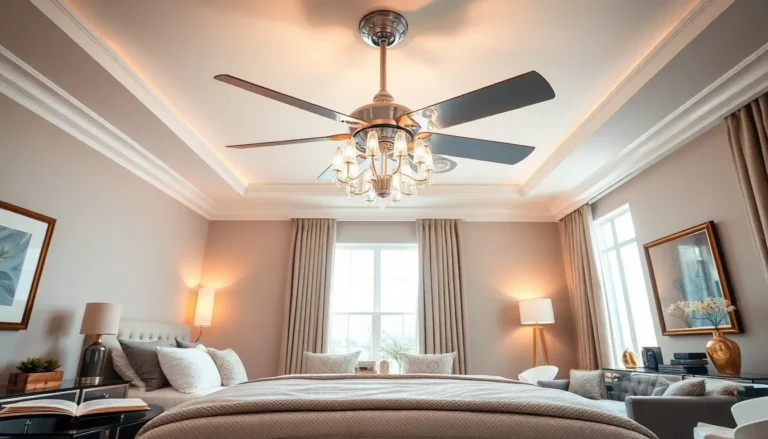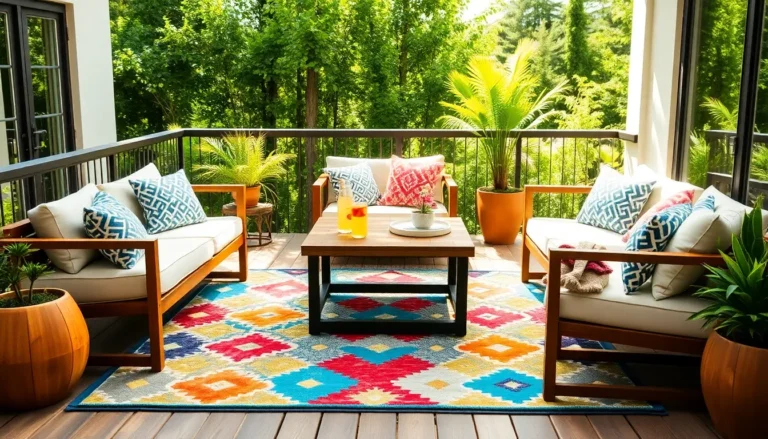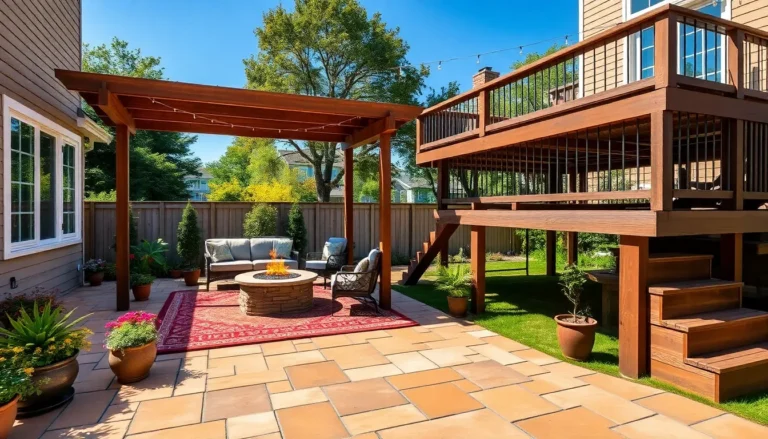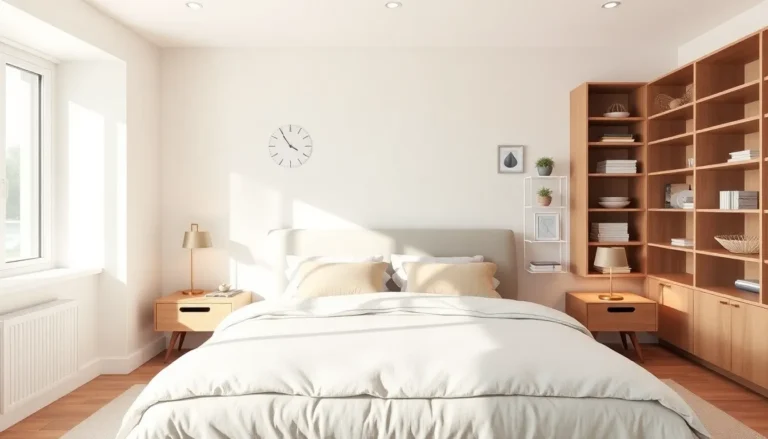Table of Contents
ToggleTransforming outdoor spaces into stunning patios isn’t just a trend; it’s a lifestyle choice that can make anyone the envy of the neighborhood. Imagine sipping your morning coffee on a stylish patio that feels like an extension of your home. With the right design, it’s not just a space; it’s a sanctuary.
Overview of Patio Designs
Patio designs vary significantly, offering numerous options for homeowners. Traditional styles include brick or stone patios that create a classic look. Modern designs often incorporate sleek materials like concrete and glass to promote a contemporary feel.
In terms of layout, L-shaped or U-shaped patios provide distinct zones for dining and relaxation. Circular configurations foster intimacy, appealing to those who prioritize social gatherings. Multi-level patios add visual interest, allowing for distinct areas such as a sunken fire pit or elevated dining space.
Materials play a crucial role in the overall aesthetic. Natural stones like granite or slate withstand the elements and enhance durability. Alternatively, composite decking offers a low-maintenance choice that emulates wood without the upkeep concerns.
Color schemes contribute significantly to the atmosphere. Earthy tones create a warm environment, while vibrant colors introduce energy and liveliness. Lighting features further enhance patio designs, enabling evening enjoyment and establishing ambiance.
Furnishing choices significantly impact both comfort and style. Loungers and outdoor sectionals provide casual relaxation, while dining tables promote gathering. Umbrellas or pergolas offer shade, crucial in warmer climates, ensuring usability throughout the day.
Incorporating greenery elevates patio spaces. Potted plants and vertical gardens introduce natural beauty, improving air quality and aesthetics. Water features, such as fountains or ponds, cultivate a serene atmosphere, inviting tranquility into the outdoor environment.
Accessibility remains a vital aspect of patio designs. Smooth transitions between indoor and outdoor spaces streamline movement. Properly placed pathways enhance navigation, ensuring safety and convenience for all users. Understanding these elements leads to the creation of functional, attractive patios that enhance outdoor living experiences.
Popular Patio Styles
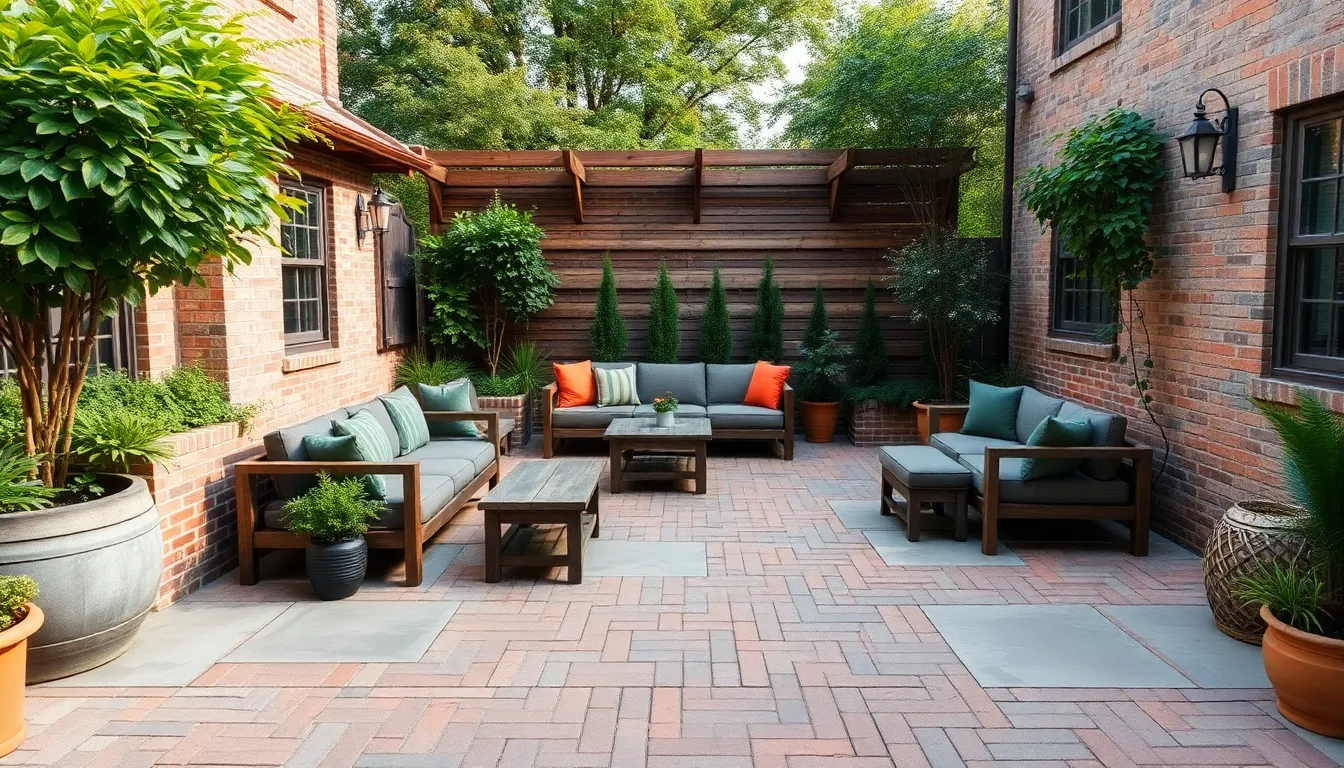
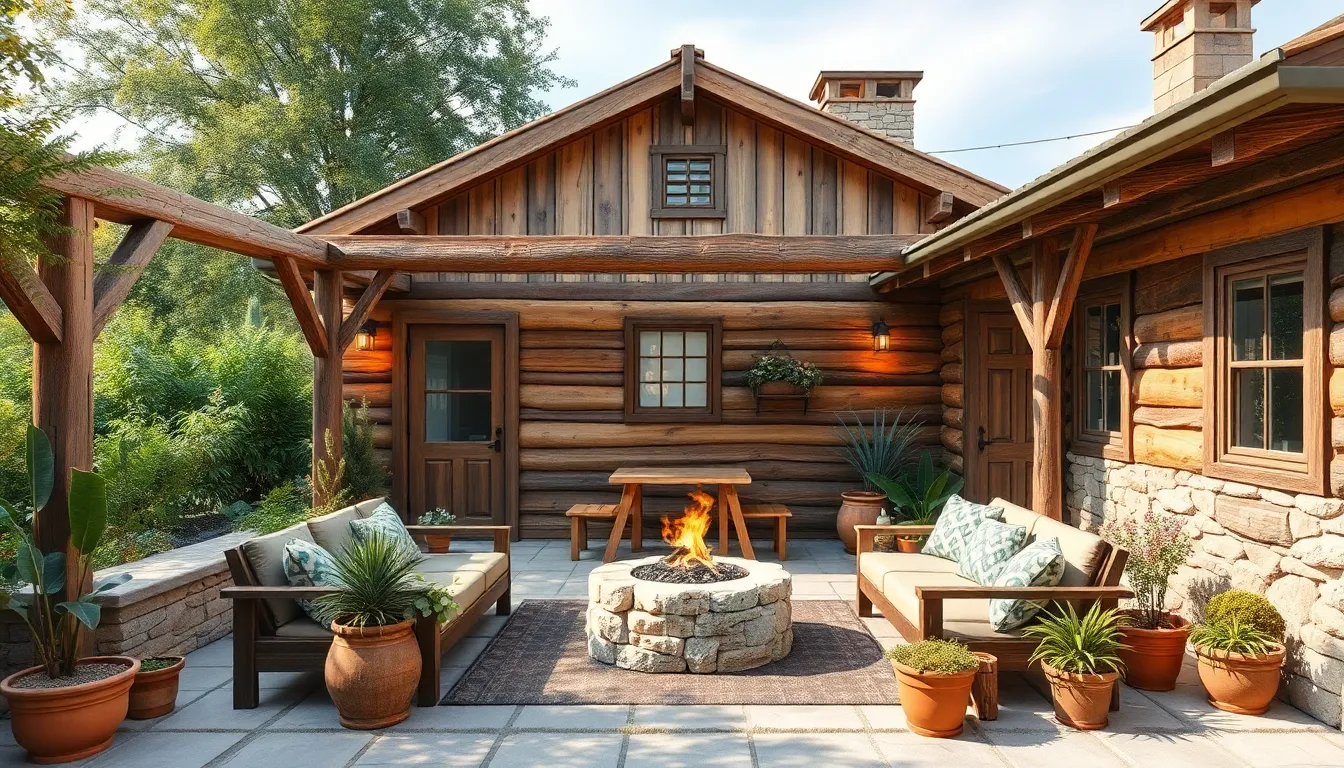
Patio designs vary greatly, accommodating different tastes and lifestyles. Each style highlights unique characteristics, making outdoor spaces appealing and functional.
Traditional Patios
Traditional patios often feature materials like brick or stone, providing a timeless aesthetic. These patios blend well with classic home designs, offering elegance and durability. Layouts may incorporate symmetrical patterns, easy flow, and defined areas for dining or entertaining. This style complements outdoor furniture that emphasizes comfort and nostalgia. Additionally, traditional patios can enhance curb appeal while requiring minimal maintenance through proper sealing and care.
Modern Patios
Modern patios utilize sleek materials such as concrete and glass, creating a minimalist approach to outdoor living. Lines are clean, and spaces are often open and airy, promoting relaxation and enjoyment. Integrating unique furnishings and innovative lighting enhances the contemporary vibe. Patios in this style often feature multi-level designs to maximize space while providing distinct areas. These setups cater to socializing by simplifying outdoor dining experiences and providing ample room for gatherings.
Rustic Patios
Rustic patios evoke a cozy, inviting atmosphere through natural materials like wood and stone. They often showcase organic shapes and earthy tones, connecting occupants to nature. Incorporating elements such as fire pits, rustic furniture, and greenery enhances warmth and charm. This design style promotes a relaxed ambiance, ideal for informal gatherings. Paths lined with natural stones or gravel add to the authenticity, creating a seamless blend between indoor and outdoor experiences.
Materials Used in Patio Designs
Selecting the right materials influences both the aesthetics and functionality of patios. Various options exist, each with unique characteristics that cater to different design preferences.
Concrete
Concrete offers a versatile base for patios. It comes in several finishes, such as stamped or stained, enhancing visual appeal. Durability stands out as a key advantage, with proper maintenance resulting in long-lasting surfaces. Budget-friendly options exist, allowing for expansive outdoor spaces at a reasonable cost. Additionally, its ability to mimic other materials adds to its allure, making it suitable for various design themes.
Pavers
Pavers come in different shapes, sizes, and colors, providing endless design possibilities. They create distinct patterns, allowing for personalized aesthetics in any outdoor area. Interlocking designs promote stability and drainage, reducing the risk of shifting over time. Easy installation and replacement contribute to their popularity among DIY enthusiasts. Maintenance is straightforward, often requiring simple cleaning to preserve appearance.
Natural Stone
Natural stone brings an organic feel and elegance to patios. Options like granite, slate, and limestone provide diverse looks, each offering unique textures and colors. Its longevity adds to the appeal, making natural stone a sound investment. The character of natural stone enhances outdoor spaces, creating a connection with nature. Installation can be labor-intensive, but the visual payoff makes it worth the effort.
Decorating Your Patio
Decorating a patio involves thoughtful selection of furniture and lighting to create an inviting outdoor space. A well-decorated patio enhances comfort and encourages relaxation.
Furniture Ideas
Comfortable seating options are essential for patio enjoyment. Sectional sofas provide ample space for gatherings, while individual chairs offer flexibility in arrangement. Consider weather-resistant materials, such as teak or aluminum, which withstand the elements. A dining set can transform the patio into an alfresco dining area, enabling outdoor meals with family and friends. Adding cushions in vibrant colors or patterns injects personality into the space. Low-profile coffee tables invite casual lounging and serve as surfaces for drinks and snacks. Decorative elements like outdoor rugs and throws enhance aesthetics and warmth, making the patio a true extension of the home.
Lighting Options
Effective lighting elevates the patio atmosphere at night. String lights create a whimsical ambiance, providing soft illumination. Lanterns, whether hanging or placed on tables, add stylish accents and flexibility in design. Consider pathway lights to enhance safety and highlight landscaping features. Wall-mounted sconces offer targeted lighting for reading or dining. Incorporating dimmable fixtures allows for adjustable brightness levels, catering to different activities and moods. Solar lights are energy-efficient options that contribute to eco-friendly designs. Incorporating fire pits or outdoor fireplaces adds warmth and creates a focal point, extending the use of the patio into the evening hours.
Maintenance Tips for Patios
Regular maintenance keeps patios looking great and prolongs their lifespan. Remove debris like leaves, dirt, and pollen to prevent stains and mold growth. Use a leaf blower or broom for efficient cleaning.
Power washing is effective for deeper cleans. This method removes stains from spills or algae. Use it at least once a year, especially in damp climates.
Sealants protect materials from weather damage. Apply a sealant for natural stones and concrete every two to three years. This provides a barrier against moisture and UV rays.
For paver patios, check for shifting stones frequently. Realign or replace any loose or cracked pavers to maintain safety and aesthetics. Use polymeric sand between pavers to minimize weed growth.
Weed control is crucial for maintaining cleanliness. Hand-pull weeds as soon as they appear. Consider using an organic herbicide to limit chemical exposure in outdoor spaces.
Monitor furniture regularly. Clean cushions and surfaces to prevent mildew. Store items indoors during harsh weather to extend their life.
Inspect lighting fixtures regularly for safety. Clean lenses and replace bulbs as needed to ensure proper visibility at night. Energy-efficient LED options provide long-lasting illumination.
Consider seasonal maintenance. Prepare patios for winter by clearing snow and ice. In spring, check for plant growth around the edges, and trim as necessary.
Seek professional help when needed. Consult expert services for issues that require specialized knowledge, such as extensive repairs or difficult cleaning tasks. Regular attention simplifies patio upkeep, ensuring a welcoming outdoor space year-round.


